Short Book Reviews
Hanna Kryszewska, Poland
Hanna Kryszewska is a teacher, teacher trainer, trainer of trainers. She is a senior lecturer at the University of Gdańsk, and EU Teacher Training College where she trains pre-service teachers. She is co-author of resource books: Learner Based Teaching, OUP, Towards Teaching, Heinemann, The Standby Book, CUP, Language Activities for Teenagers, CUP, The Company Words Keep, DELTA Publishing, and a course book series for secondary schools: ForMat, Macmillan. She is also co-author of a video based teacher training course: Observing English Lessons. Hania is a Pilgrims trainer and editor of HLT Magazine.
E-mail: hania.kryszewska@pilgrims.co.uk
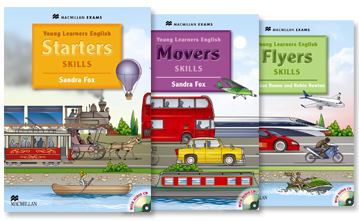
Young Learners English. Starters. Movers. Flyers. Skills. Macmillan Exams. S. Fox. S. Fox. B.Dunne and R. Newton. (2014) Macmillan. ISBN 978-0-230-44899-5, 978-0-230-44904-6, 978-0-230-44909-1 pp71, 96, 96 (respectively). The three books have been published in the Macmillan’s Young Learners English Series. They are activity based books which aim at practising the skills, vocabulary and grammar which learners need to successfully pass the given YLE Tests (Cambridge English Young Learners English tests). They prepare YL for the Starters, Movers or Flyers exam, possibly the learners’ very first language exam of their lives. The books offer student-centered and effective practice of all the exam skills needed for the exam. There are a lot of motivating, practical and fun activities, which the learners are bound to enjoy. Each book is divided into three parts: Part 1 - practice of vocabulary and structure, Part 2 - progressive activities preparing the learners for the exam, and finally, Part 3 – exam styles activities which combine the themes, vocabulary and grammar necessary to pass the exam successfully. Each book in the series is accompanied by a teacher’s book which gives the teacher all the necessary support, audio-scripts, keys, as well as photocopiable resources, and vocabulary and structure lists. The teacher also receives a webcode which gives access to the teachers’ website for more extra practice and exam papers.
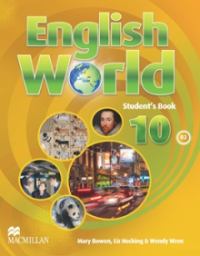
English World 10: Student’s Book. M. Bowen, L. Hocking and W. Wren. Macmillan. (2013) ISBN 978-0-230-03255-2, pp.129.This course book is part 8 of a new ten level general English course which is aimed at children at primary level and teenagers at a secondary level. (NB The blurb on the back states that the book in question is aimed at the secondary level – B2 according to CEFR). The course has a skills based approach which is the springboard for grammar and vocabulary work in context. The choice of texts and genres is very varied and interesting, with a strong CLIL element. The layout of the book and the visual materials are varied and pleasing to the eye. The full course comes complete with the usual components: a workbook with a CD-ROM, a teacher’s guide, audio CD’s, an exam practice book, as well as with a teacher’s digibook. Personally I am not sure which country and what pedagogical set-up the whole course is intended for. In my experience teachers and educators in many countries prefer that every level of education, early primary, primary, early secondary and secondary, uses a new course specifically written for the given age group. Learning or teaching from the same course, no matter how good it is, for ten consecutive years may become tedious and demotivating for both learners and the teachers. However, if the whole course is seen as a ‘menu’ to choose from and only some parts are to be used, e.g. on a summer course, then the individual books are a good choice and good value for money.

Insights Course: Student’s Books 1-6. J. Garton-Sprenger and Philip Prowse with M. Baccarin, H. Gomm and C. Smith. Parts 1-4 first published 2008, republished 2013; Parts 5-6 published 2013) ISBN 978-0-230-42740-2, 978-0-230-43408-0, 978-0-230-43414-1, 978-0-230-43420-2, 978-0-230-43426-4, 978-0-230-43426-4, 978-0-230-42740-2, 978-0-230-43432-5; pp.151, 127, 127, 127, 159, 159, respectively.This six part general English course is aimed at teenagers from near-beginner to intermediate level (A1 – B1+). The course reflects the needs of the learners as their interests and needs change. The topics are relevant to the particular age group and include cross-curricular and intercultural content, as well as tasks which require the use of English in the learners’ own environment. The course has a skills based approach, in which language functions, grammar and lexis are closely linked to the skills themselves. Production of language requires speaking in motivating activities while writing tasks are both guided and open-ended. The strong points of the course are: developing learner independence and awareness of individual learning styles. The coursebook and workbook are bound together which makes the two parts of the course easy to use. The full course comes with support material in the teacher’s book and optional extra on-line practice for the learners. The books in the course are pleasing to the eye, although some pages seem to be jam-packed, others look a bit empty with relatively big font, which looks a bit like a ‘space filler’. As in the case of the World 1-10 Macmillan course it is hard to tell what pedagogical environment the course is aimed at. I cannot think of a school system in which a 6 level teenage course is suitable. However, the whole course can be used selectively, or is ideal for a summer language course.
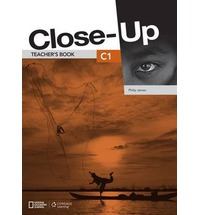
Close-Up C1. A. Healan and K. Gormley. National Geographic Learning. CENGAGE LEARNING (2013), ISBN 978-1-4080-6174-9, pp. 190.The book is part four of a new four level course ( B1 – C1) designed for young adult or adult learners of English. It is an innovative course which uses spectacular National Geographic texts accompanied by fascinating texts which appeal to those who like to combine learning the language with learning about the world. The materials offer a ‘close-up’ on the surrounding world, hence the course title. The approach in the book offers a balance between language skills, grammar and vocabulary. The topics include: exploring the world, adventures, inventions, money, outer space, film and food. The coursebook comes with a theme-related National Geographic DVD with footage for each unit, CD’s, a teacher’s book and interactive whiteboard software. The course book is pleasing to the eye, and the visual material chosen by the editor does not clash or compare unfavourably when combined with the stunning National Geographic photography. I am sure there will be many learners who will enjoy learning from the book.
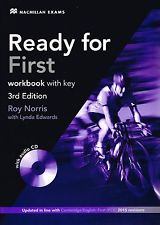
Ready for First. R. Norris. Macmillan (2013), ISBN 9780230440012, pp. 239. The book is designed for learners preparing for the Cambridge English: First (FCE) examination. This is the third edition of the course (the earlier editions were called Ready for FCE , by the same author). This new edition is not just a facelift of the old course. It contains many new texts and activities, as well as additional materials on MPO (Macmillan Practice Online), although the approach to exam preparation remains the same. The author follows the task-based approach which is very effective in exam preparation. Most of the reading, listening, speaking and writing tasks are in the exam-style, and the writing sections are supported by materials in the writing bank and model answers. I am sure that the book, like its earlier versions, will guarantee effective, systematic and smooth exam preparation. The book is visually appealing, and, fortunately, some of the less aesthetic drawings to be found in the previous editions are gone, and have been replaced by more aesthetic ones. Ready for FCE along with Ready for CAE have been my favourite ESOL exam preparation courses for years. I am sure there will be no change when I start teaching from the new edition.
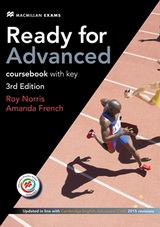
Ready for Advanced. R. Norris with Amanda French. Macmillan (first published 2004; this edition 2014), ISBN 9780230463691, pp. 239). The book is designed for learners preparing for the Cambridge English: Advanced (CAE) examination. This is the third edition of the course; the earlier courses were called Ready for CAE (by Roy Norris only). This new edition contains many new texts and activities, as well as additional materials on MPO (Macmillan Practice Online), although the approach to exam preparation remains the same. The authors follow the task-based approach which is very effective in exam preparation. Most of the reading, listening, speaking and writing tasks are in the exam-style, and the writing sections are supported by materials in the writing bank and model answers. I am sure that the book, like its earlier versions, will guarantee effective and smooth exam preparation. Ready for CAE along with Ready for FCE have been my favourite ESOL exam preparation courses for years. I am sure there will be no change when I start teaching from the new edition.
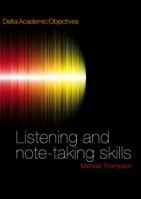
Listening and note-taking skills. M. Thompson. DELTA Publishing. (2013). ISBN 978-1-905085-60-6, pp112. This book has been published in the Delta Academic Objectives series, which has been designed to help students to learn to study in English or in an English speaking environment or to use English in the business world. The book in question not only helps the students to listen to lectures and take notes, but also helps to develop essential presentation and speaking skills. It has a balanced skills approach but what stands out is the listening material which contains over 3 hours of listening material (3 CD’s come with the book). The recordings are extended listening passages which develop the students’ ability to listen for longer periods of time, very common in the academic or business environment. The sections in the book include language focus, listening for production and listening for meaning, and finally vocabulary focus. The book can be used in class as well as for self study, thanks to the key and audio transcripts at the end of the book.
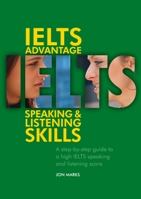
IELTS Advantage. Speaking & Listening Skills. J. Marks. (2013) DELTA. ISBN 978-1-905085-66-4, pp 120. The book has been published in the DELTA IELTS Advantage coursebook series. (There are also IELTS Advantage Reading Skills and IELTS Advantage. Writing Skills). It is aimed at students who are at the Band 6.5 or higher levels. The publishers approach is to separate the particular skills to help students who need extra practice and have to work more on one particular skill to get a better result in the exam. The activities and tasks focus on general English language skills, and these skills in the IELTS exam context. There is a lot of focus on vocabulary, especially collocations and using the dictionary effectively. The CD which comes with the book gives examples of models for speaking performances in the exam and contains exam like leistering. The book is suitable for class use but much more so for self-study thanks to a step-by-step approach, many useful tips, advice on useful strategies and good practice. Needless to say there is a key at the end so the students can check their answers themselves.
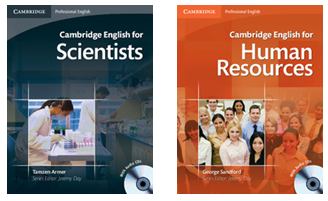
Cambridge English for… series. Series editor Jeremy Day. Cambridge English for Scientists. T. Armer. (2011) ISBN 978-0-521-15409-3, pp.128. Cambridge English for Human Resources. G. Sandford. (2011) ISBN 978-0-521-18469-4, pp.128.Cambridge University Press.These books were published in the Cambridge Professional English series which is aimed at B1 – B2 learners of English, who would like to use English in a professional environment. Each book offers a short 40 – 60 hour course in which professional skills and language are taught and practised therough practical tasks and communication. Future or practising scientists learn how to apply for research funding, writing for publication, presenting at a conference, while those in human resources learn how to conduct an interview, how to coach or how to create disciplinary or grievance procedures. The books are rich in texts, diagrams and relevant visual material; they also come with listening material on CD’s. Highly recommended.
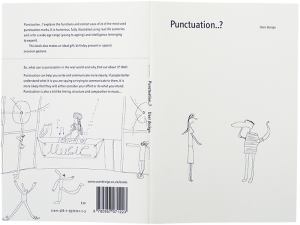
Punctuation..? User design. (2013). ISBN 9780-0-9570712-2-3, pp 35.This charming book looks at the most commonly used punctuation marks in English. The contents page lists the 20 marks which the book deals with in ‘mini chapter’ form. Each ‘mini chapter’ is illustrated with nice drawings which are in some way related to the way the given punctuation mark is used or are a visual anecdote illustrating the text. Each ‘chapter’ gives facts about the use of the given punctuation mark, some examples, traps or exceptions. (For a sample two page spread see below.)
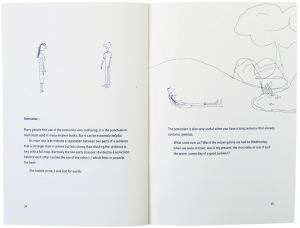
The book brings to my mind another book, namely Eats, Shoots & Leaves by Lynne Truss, as it is also exclusively devoted to punctuation. It might seem it is a pretty dry subject, yet both the books have a lot of charm and fun about them. The price is £10, and as the publisher states it is ‘an ideal gift, birthday present or special occasion gesture’. I particularly like the latter and I am planning to give it to those who are venturing on major academic ventures, like writing a Ph.D.
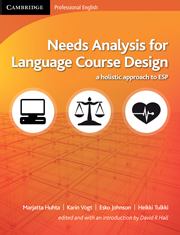
Needs Analysis for language Course Design A holistic Approach to ESP. M. Huhta, E. Johnsson and H. Tulkki.(2013) Cambridge University Press. ISBN 978-0-521-12814-8, pp 266. The book has been published in the Cambridge Professional English series and is aimed at teachers who have to design tailored language courses ‘for professionals at work, vocational schools, and graduate and undergraduate students of any discipline’. It has been written by international experts who have been involved in researching the implementation of the Common European Framework Professional Profiles, a project which was funded by Leonardo da Vinci EU research programme for vocational education and training. Professional Profiles uses an evidence-based approach, which among others identifies and addresses a variety of skills and discourses a professional language learner has to master to be successful in their careers when using English. The book first looks at needs analysis of a learner on an ESP course, then ways of moving from teaching ESP to teaching language and Communication for Professional Purposes; then looks at ways of putting together sample learners profiles, and finally creating CEF Professional Profiles. The book is very clearly structured and easy to follow. I am sure each teacher who picks up the book, no matter how experienced, will benefit from it especially when it comes to planning, designing and delivering focused and effective language courses. Highly recommended.

Please check the Methodology and Language for Primary Teachers course at Pilgrims website.
Please check the Methodology and Language for Secondary Teachers course at Pilgrims website.
Please check the Teaching Advanced Students course at Pilgrims website.
Please check the CLIL for Universities course at Pilgrims website.
Please check the Practitioner Course in Developing Business English Skills course at Pilgrims website.
Please check the How to be a Teacher Trainer course at Pilgrims website.


|